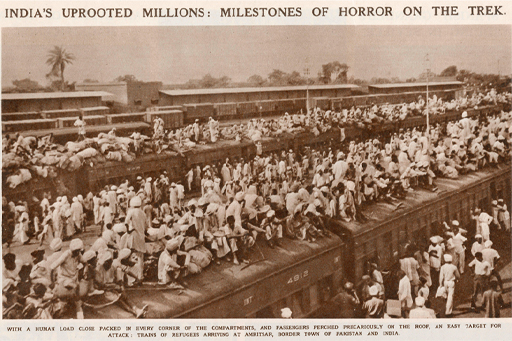1 Colonial legacies: Partition of India, 1947
Indian decolonisation was not a moment but a process with a long arc. This section considers one aspect of that process – the Partition of India in 1947. The traumatic events of Partition created a legacy which shaped the post-independence relationship between India, Pakistan, and later Bangladesh. For the individuals and families involved, the violence and pain of separation and loss continues to impact their lives.
India was home to different religious groups including Hindus, Muslims, Sikhs, Buddhists, Jews and Christians. Independence posed questions about how minority faith groups, particularly Muslims who constituted the largest minority, might be treated in the context of a Hindu dominated population. There was a history of communal violence between Hindus and Muslims, and the British colonial rulers drew on this division to weaken opposition to imperialism. Partition of Bengal in 1905 was enacted by the British along religious lines.

Different kinds of post-colonial nationalism developed imagining different futures for an independent India. These included a federalised system in which provinces where the Muslim population was dominant would play a role in a unified Indian state. They also included Muslim separatism through the establishment of two nation states – India and Pakistan – split along religious lines.
India’s Partition was Britain’s final policy in exiting the colony. Cyril Radcliffe (1899–1977) was appointed to chair the boundary commission and given just five weeks to divide the land, resources, and people into two nations.
The boundaries of India and Pakistan were not announced to the Indian public until after independence was declared, in a vain attempt to prevent further communal violence. The borders left many Muslims in India, and many Hindus in Pakistan. A mass exodus ensued as members of both communities tried to cross the new borders. This movement turned violent, with the police and army’s role in attempting to protect people largely sporadic given the sheer scale of the violence.
The massacres of whole villages led to mass panic, as millions of people decided to move to either India or Pakistan depending on their religion. As they moved, they were highly vulnerable to attack, especially on the roads, on trains and in train stations. For many people who, depending on their religion, found themselves on the ‘wrong’ side of the border, there was a great risk that staying put would result in them being killed. Equally, trying to move across these new borders was fraught with danger, risking rape, torture, and massacre. Law and order broke down for weeks after August 1947 in Punjab and Bengal, as the cycle of violence escalated.
Over one million people died from August 1947 to the year’s end. Historians are divided over interpreting Partition. Some regard the communal violence as inevitable due to long standing tensions between local forces within the subcontinent. Others see Partition as primarily the result of British colonial mistakes.
Partition is a traumatic legacy for many South Asian families. Conflict between India and Pakistan over contested borders which were drawn up during Partition continue today, with three wars having been fought over the disputed Kashmir region.
Activity 1 Dividing people: the legacies of Partition
This blog [Tip: hold Ctrl and click a link to open it in a new tab. (Hide tip)] by Anam Zakaria sets out some of the context for and legacies of Partition. It includes transcriptions of oral history interviews with those who experienced Partition first hand. Read the blog and answer these questions:
- What legacies of Partition does the author identify?
- Pick ONE of the oral history interviews and make notes about the personal impact of Partition on the interviewee.
Discussion
- The author estimated that 15 million people were displaced, 75,000 women were abducted and raped, and between 200,000 and 2 million people were killed. This had an enormous personal impact and it also shaped relations between India, Pakistan, and Bangladesh. Three major wars between these nations have been fought including the 1971 conflict which led to Bangladesh gaining independence. Previously porous borders have now become very difficult to cross. There has been a rise in religious nationalism with serious consequences for minority groups.
- Malik Siddiqui, Pakistan. Malik was committed to the idea of Pakistan which he felt was a homeland. Although his parents lived in India and did not want to leave, he decided to make the move. At the time there was very little restriction on travel. He did not see his family again for three years and said that the separation from them was hard. The harsh border policies which were enacted after the 1965 war made it very difficult to travel to see his family. He missed his parents’ funeral as he could not get a visa. Reflecting back, he was happy with his decision but noted that he had to make very significant personal sacrifices as a result.
